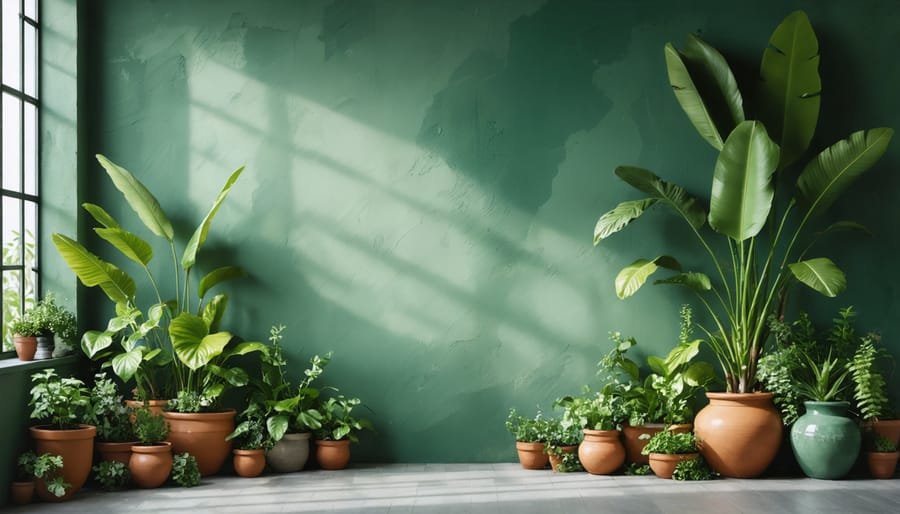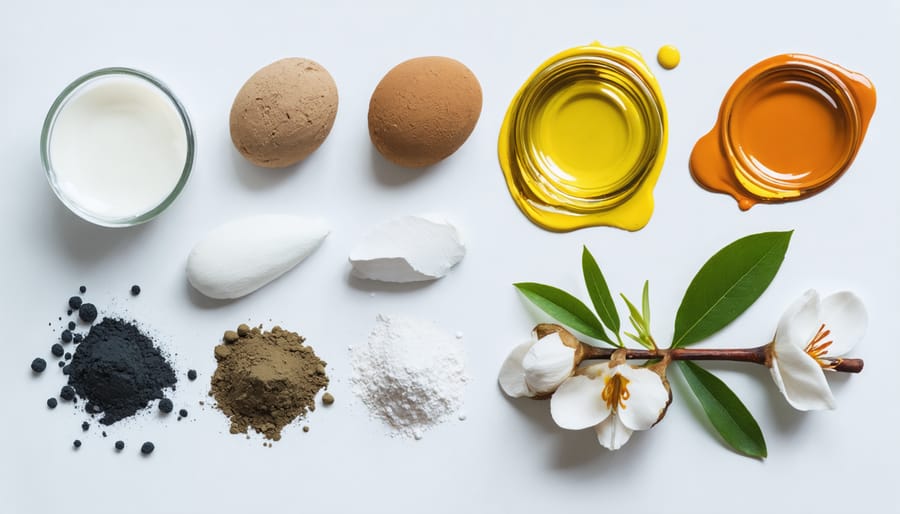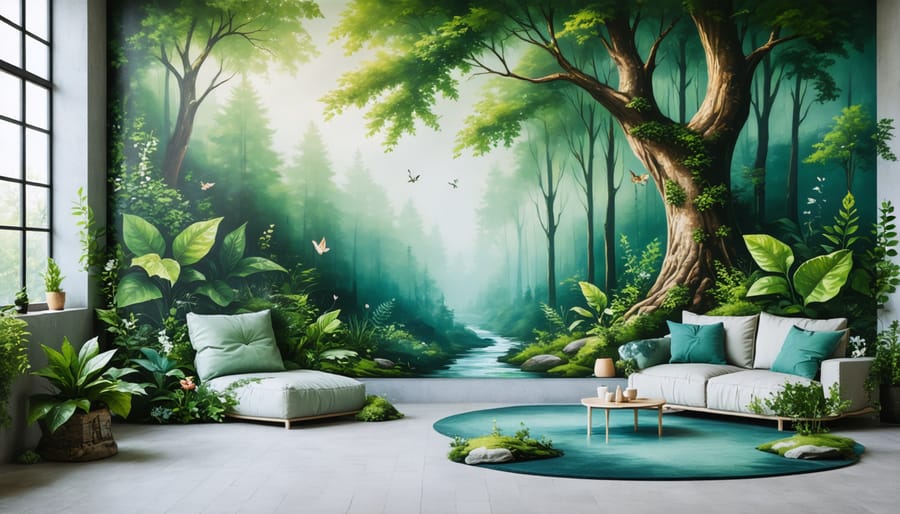
Transform Your Home with Earth-Friendly Wall Paint (That Actually Looks Amazing)
Transform your living space while protecting the environment by choosing eco-friendly paint options that minimize harmful chemicals and reduce your carbon footprint. Modern sustainable wall paints harness natural ingredients like clay, milk protein, and plant-based materials to create durable, beautiful finishes without compromising indoor air quality. These innovative formulations not only eliminate up to 90% of volatile organic compounds (VOCs) found in traditional paints but also offer superior breathability, helping regulate indoor humidity and prevent mold growth. Beyond environmental benefits, sustainable paints deliver rich, authentic colors that create warm, inviting spaces while supporting better health for your family. The natural pigments and minerals used in these formulations often result in deeper, more complex color variations that add character to your walls – proving that eco-conscious choices can enhance both your home’s aesthetics and its environmental impact.
What Makes Wall Paint Sustainable?
Low and Zero VOC Formulations
Volatile Organic Compounds (VOCs) are harmful chemicals that traditionally lurk in conventional paints, releasing gases into your home long after the paint dries. These compounds can cause headaches, respiratory issues, and other health concerns, while also contributing to environmental pollution. That’s where low and zero VOC paints come in as game-changers for sustainable home decoration.
Low VOC paints contain less than 50 grams per liter of volatile compounds, while zero VOC options have less than 5 grams per liter. These environmentally friendly alternatives are made with water-based formulations and natural ingredients instead of harmful solvents. They deliver the same beautiful finish as conventional paints but without the chemical smell and health risks.
When shopping for low or zero VOC paints, look for third-party certifications like Green Seal or GREENGUARD. These verify the manufacturer’s claims and ensure you’re getting a genuinely sustainable product. Many major paint brands now offer these healthier options, making it easier than ever to choose safer paints that protect both your family and the planet.
Keep in mind that even zero VOC base paints might have some VOCs added when tinted with colorants, so always ask about the final VOC content of your chosen color.

Natural and Renewable Ingredients
Modern sustainable wall paints embrace nature’s bounty, using ingredients that are both environmentally responsible and effective. Plant-based oils, such as linseed, sunflower, and soybean, form the foundation of many eco-friendly paints, replacing traditional petroleum-based binders. These natural oils provide excellent coverage while maintaining a low environmental impact.
Clay and chalk serve as natural pigments and fillers, offering rich, earthy tones without synthetic dyes. Many manufacturers also incorporate milk protein (casein) as a natural binding agent, a technique that dates back centuries. Essential oils like citrus and lavender not only act as natural preservatives but also provide pleasant, non-toxic fragrances.
Water-based formulations use natural minerals like titanium dioxide and iron oxide for coloring, while plant-derived resins provide durability. Some innovative brands even incorporate recycled materials, such as marble dust and reclaimed calcium carbonate, reducing waste while creating beautiful finishes.
These natural ingredients ensure that your walls can breathe, regulating indoor humidity and creating a healthier living environment. Plus, they’re renewable resources that can be sustainably harvested, making them a truly eco-conscious choice for your home.

Top Sustainable Paint Options for Your Walls
Mineral-Based Paints
Mineral-based paints offer an exceptional choice for those pursuing sustainable interior design. These paints are made primarily from natural minerals like limestone, clay, and silicates, making them one of the most eco-friendly options available. Unlike conventional paints, mineral paints create a chemical bond with the surface they’re applied to, resulting in exceptional durability and a breathable finish that helps prevent mold growth.
The unique composition of mineral paints offers several advantages: they’re naturally fire-resistant, highly alkaline (which inhibits bacterial growth), and completely VOC-free. While they typically cost more upfront than conventional paints, their longevity often makes them more cost-effective in the long run. They work particularly well on mineral-based surfaces like concrete, stone, and plaster, creating a distinctive matte finish that many homeowners love.
These paints are ideal for both interior and exterior applications, though they require proper surface preparation for optimal results.
Plant-Based Paints
Plant-based paints represent one of nature’s most sustainable solutions for wall finishes. These eco-friendly alternatives are crafted from renewable resources like linseed oil, citrus oils, and plant resins, offering a genuinely green option for conscious homeowners. The most common plant-derived ingredients include soy, corn, and other vegetable oils that replace traditional petroleum-based components.
What makes these paints particularly appealing is their minimal environmental impact and zero VOC emissions. They’re completely biodegradable and safe for both people and pets. Many plant-based paints also incorporate natural pigments from sources like berries, flowers, and minerals, creating rich, authentic colors that bring warmth to any space.
While they might require more frequent reapplication than conventional paints, plant-based options often provide better breathability for your walls and contribute to healthier indoor air quality. They’re particularly well-suited for bedrooms, nurseries, and spaces where air quality is a top priority.
Recycled Content Paints
Recycled content paints represent an innovative approach to sustainable wall finishes, incorporating post-consumer materials that would otherwise end up in landfills. These paints typically contain recycled plastic, unused paint from construction projects, and reclaimed industrial materials. Many manufacturers now process these materials into high-quality paint products that perform just as well as traditional options.
The recycled content can range from 25% to 80%, depending on the manufacturer and paint type. Some brands even use paint recovered from household hazardous waste collections, which they filter, test, and reprocess into new products. These paints often come in a wide variety of colors and finishes, dispelling the myth that eco-friendly options limit your design choices.
Besides reducing waste, recycled content paints often cost less than conventional paints while maintaining excellent coverage and durability. When shopping, look for certification labels that verify recycled content claims and ensure the paint meets quality standards. Many professional painters now recommend these options for both residential and commercial projects.
Application Tips for Best Results

Surface Preparation
Proper wall preparation is crucial for achieving a flawless, long-lasting finish with your sustainable paint. Start by clearing the room and laying eco-friendly drop cloths to protect your floors. Clean the walls thoroughly using a mixture of warm water and mild, biodegradable soap to remove dirt, grease, and grime. For stubborn stains, try natural cleaning solutions like vinegar and water.
Next, inspect the walls for cracks, holes, or imperfections. Fill these with eco-friendly spackle or natural wall fillers, and allow them to dry completely. Sand the repaired areas gently using fine-grit sandpaper, then wipe away all dust with a damp cloth. For previously painted walls, lightly sand the entire surface to create a better bonding surface for your new paint.
If your walls have any mold or mildew, address these issues with natural remedies like tea tree oil solution before painting. Finally, apply an eco-friendly primer if needed, especially on bare drywall or heavily repaired surfaces. Allow the primer to dry completely according to the manufacturer’s instructions before beginning your sustainable paint application.
Remember to maintain good ventilation throughout the preparation process by opening windows and using fans.
Application Techniques
Proper application of sustainable wall paint is crucial for achieving the best results while maintaining eco-friendly benefits. Start by thoroughly cleaning your walls and repairing any cracks or holes. Unlike conventional paints, many sustainable options require less aggressive prep work, but a clean surface is still essential.
Apply a natural primer if needed, especially on new drywall or significantly stained surfaces. Most sustainable paints work best when applied in thin, even coats using high-quality brushes or rollers made from natural materials. Work in small sections, maintaining a wet edge to prevent lap marks.
For best coverage, apply two coats, allowing adequate drying time between applications. Many eco-friendly paints have shorter drying times than traditional options, but always check the manufacturer’s recommendations. Keep the room well-ventilated during application, even though sustainable paints typically emit fewer VOCs.
Use smooth, overlapping strokes and avoid overworking the paint, as this can affect the final finish. For textured walls, use a roller with an appropriate nap length to ensure even coverage in all the grooves and valleys.
Maintaining Your Sustainable Paint Job
Maintaining your sustainable paint job doesn’t have to be complicated. With proper care, your eco-friendly walls can maintain their beauty and durability for years to come. Start by dusting your walls regularly with a soft microfiber cloth or duster to prevent dirt buildup. For tougher spots, use a gentle, natural cleaning solution of warm water and mild dish soap – avoid harsh chemical cleaners that can damage the paint and release toxins into your home.
Keep an eye on humidity levels in your home, as sustainable paints can be more sensitive to moisture. Use dehumidifiers in damp areas and ensure proper ventilation, especially in bathrooms and kitchens. Address any water leaks promptly to prevent paint damage and potential mold growth.
Touch up any scratches or marks as soon as you notice them to prevent further deterioration. Always keep some leftover paint properly stored in an airtight container for these quick fixes. Store your paint in a cool, dry place away from direct sunlight and extreme temperatures.
Regular maintenance inspections every six months can help you spot potential issues before they become problems. Look for signs of peeling, bubbling, or discoloration, particularly in high-moisture areas. If you notice any concerning changes, address them quickly to maintain the integrity of your sustainable paint job.
Remember that sustainable paints often improve indoor air quality, so maintaining them properly helps preserve this benefit for your home’s environment.
Choosing sustainable wall paint is more than just a trend – it’s a meaningful step toward creating healthier, more environmentally responsible living spaces. By selecting eco-friendly paint options, you not only protect your family from harmful VOCs but also contribute to cleaner air quality and reduced chemical waste. The benefits extend beyond environmental impact, offering excellent coverage, durability, and stunning aesthetic results that rival traditional paints.
As we’ve explored throughout this guide, sustainable paints provide a perfect balance of performance and planetary responsibility. Whether you’re renovating your home or starting a new project, these earth-friendly alternatives make it easier than ever to reduce your home’s environmental impact without compromising on quality or style.
Take the first step today by choosing sustainable paint for your next project. Your walls – and our planet – will thank you for making this conscious choice. Remember, every small decision towards sustainability adds up to create meaningful change for future generations. The path to a greener future starts with the choices we make today, including the paint we put on our walls.
